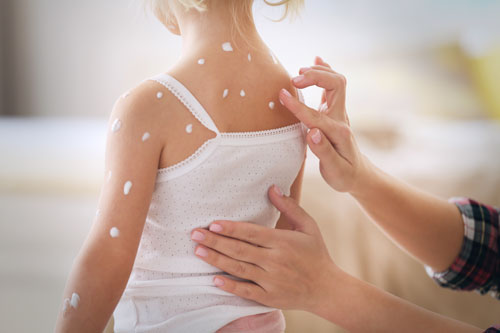[print-me]
Description
Chicken pox is a very contagious, mild disease caused by herpes zoster virus. It can affect all ages, but most common in children.
Frequent Signs and Symptoms
- The following are usually mild in children, severe in adults:
- Fever.
- Abdominal pain or general ill feeling that lasts 1-2 days.
- Skin eruptions that appear almost anywhere on the body, including the scalp, penis, and inside the mouth, nose, throat or vagina. They may be scattered over large areas, and they occur least on the arms and legs. Blisters collapse within 24 hours and form scabs. New crops of blisters erupt every 3 to 4 days.
- Adults have additional symptoms that resemble influenza.
Causes
- Infection with the herpes zoster virus. It is spread from person to person by airborne droplets or contact with skin eruption on an infected person. Incubation after exposure is 7 to 21 days.
- A newborn is protected for several months from chickenpox if the mother had the disease prior to or during pregnancy. The immunity diminishes in 4 to 12 months.
Risk Increases with use of immunosuppresive drugs.
 Preventative Measures
Preventative Measures
Cannot be prevented at present. An immune globulin is available for high-risk persons, such as those who take anti-cancer or immunosuppressive drugs. Live attenuated (weakened) vaccines are currently being developed.
Expected Outcome
- Spontaneous recovery. Children usually recover in 7 to 10 days. Adults take longer and are more likely to develop complications.
- After recovery, a person has lifelong immunity against recurrence of chickenpox.
- After chickenpox runs its course, the virus sometimes remains dormant in the body (probably in the roots of nerves near the spinal cord). The same virus may later cause shingles.
Possible Complications
- Secondary bacterial infection of chickenpox blisters
- Pneumonia
- Viral eye infection
- Encephalitis (rare)
- Reye’s syndrome
- Shingles many years later in adulthood (possibly)
- Arthritis (transient)
- Myocarditis
- Scarring, if blisters become infected (rare)
TREATMENT FOR CHICKENPOX
General Measures
- Diagnosis is usually determined by the appearance of skin eruptions and laboratory tests are not necessary.
- Treatment is directed toward relieving symptoms.
- Use cool-water soaks or cool-water compresses to reduce itching.
- Keep the patient as quiet and cool as possible. Heat and sweat trigger itching.
- Keep nails short to discourage scratching, which can lead to secondary infection.
Medication
- The following non-prescription medicines may decrease itching:
- Topical anesthetics and topical antihistamines, which provide quick, short-term relief. Preparations containing lidocaine and pramoxine are least likely to cause allergic skin reactions. Lotions that contain phenol, menthol and camphor (such as calamine lotion). Follow package instructions.
- If you must reduce a fever, use acetaminophen. Never use asprin as it may contribute to the development of Reye’s syndrome (a form of encephalitis) when given to children during a viral illness.
- Acyclovir (brand name Zovirax), an antiviral medication may be prescribed.
Activity
- Bed rest is not necessary. Allow quiet activity in a cool environment. A child may play outdoors in the shade during nice weather.
- Keep an ill child away from others, away from school, until all blisters have crusted and there are no new ones.
- No special diet is necessary.
Notify Our Office If
- You or your child have symptoms of chickpox.
- Lethargy, headache or sensitivity to bright light develop.
- Fever rises over 101°F (38.3°C).
- Chickenpox lesions contain pus or otherwise appear infected.
- A cough occurs during a chickenpox infection.

 Preventative Measures
Preventative Measures